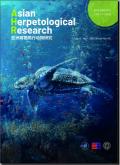末次盛冰期后中国北方两种同域蜥蜴种群动态
IF 1.2
3区 生物学
Q2 ZOOLOGY
引用次数: 2
摘要
东亚地区的狐尾蜥(Lacertidae)系统地理学研究有限,重大气候事件对其种群动态的影响仍然知之甚少。本研究旨在研究末次盛冰期中国北方两种同域分布的沙蜥(阿格沙蜥和布氏沙蜥)的种群历史和避难状况。我们对来自9个地区的128只阿法鳗和来自5个地区的46只布伦切利鳗的ND4基因部分线粒体DNA进行了测序。鉴定出44个单倍型,33个单倍型。种群扩张事件开始于约0.0044 Ma的阿古蠓和0.031 Ma的布氏蠓。brenchleyi的人口统计历史表明,自最近的共同祖先以来,E. brenchleyi的人口数量长期下降,而E. argus的人口统计历史表明,人口数量持续增长。种群间结构显著,分布范围内有多个避难所。间断性的基因流动发生在冰川期温暖阶段的多个避难所的扩大种群之间,这可能解释了为什么布伦切雷e.b arenchleyi的有效种群规模保持相对稳定,而阿格斯e.g arus的有效种群规模却在增长。本文章由计算机程序翻译,如有差异,请以英文原文为准。
Population Dynamics Following the Last Glacial Maximum in Two Sympatric Lizards in Northern China
Phylogeographic studies of Eremias lizards (Lacertidae) in East Asia have been limited, and the impact of major climatic events on their population dynamics remains poorly known. This study aimed to investigate population histories and refugia during the Last Glacial Maximum of two sympatric Eremias lizards (E. argus and E. brenchleyi) inhabiting northern China. We sequenced partial mitochondrial DNA from the ND4 gene for 128 individuals of E. argus from nine localities, and 46 individuals of E. brenchleyi from five localities. Forty-four ND4 haplotypes were determined from E. argus samples, and 33 from E. brenchleyi samples. Population expansion events began about 0.0044 Ma in E. argus, and 0.031 Ma in E. brenchleyi. The demographic history of E. brenchleyi indicates a long-lasting population decline since the most recent common ancestor, while that of E. argus indicates a continuous population growth. Among-population structure was significant in both species, and there were multiple refugia across their range. Intermittent gene flow occurred among expanded populations across multiple refugia during warmer phases of the glacial period, and this may explain why the effective population size has remained relatively stable in E. brenchleyi and grown in E. argus.
求助全文
通过发布文献求助,成功后即可免费获取论文全文。
去求助
来源期刊

Asian Herpetological Research
ZOOLOGY-
CiteScore
2.80
自引率
7.10%
发文量
441
审稿时长
>12 weeks
期刊介绍:
AHR aims to provide a forum for herpetologists and related scientists interested in conducting international academic exchanges and joint studies, and a platform for introducing their newly made scientific and technological data, and publishing their research results and achievements in the world, but focusing on the Asian-Pacific Region.
The principal criteria of AHR for acceptance of articles for publication are the quality and significance of the research, breadth of interest of the work to the readership, and the clarity and effectiveness of communication. AHR welcomes submission of manuscripts from authors in all countries of the world, though with a focus on the herpetological studies in the Asian and Pacific Region, including major articles, shorter communications and review articles.
 求助内容:
求助内容: 应助结果提醒方式:
应助结果提醒方式:


